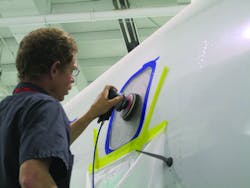Airframe Technology: Scratches and Dings
In concept, aircraft windows are just like the windows in your house. Both are designed to provide light, protect you from the elements, and let you see what is going on in the great outdoors. To function well both need to be clean, free of dings and cracks, and sealed properly. That said, aircraft windows make a radical departure and are a conundrum. Aircraft windows are some of the strongest parts of the fuselage. Many aircraft have “Cut Here In Case of Emergency” stenciled on the outside of the fuselage vs. “Break Window in Case of Emergency.”
Windows get their strength from their design, construction methods, and materials. Modern aircraft cabin windows are usually made of two layers of acrylic for thermal insulation and a clear view. The outer pain shields passengers from the very cold high altitude air and the inner pane keeps humidity from condensing and frosting.
Cockpit windows are stronger and more complicated. They are made of multiple layers of high-impact glass or stretched layers of acrylic, heating elements, and mounting hardware. The structural members of the window are usually designed to withstand 1.5 times the normal operating pressure. These windows must provide the flight crew a clear view, remain ice free, shed rain, and withstand bird, lightening, hail, and runway FOD strikes. They do this well. Make an Internet search and you’ll find cases where aircraft windows have sustained incredible hail damage.
I had the opportunity to work on a Boeing 707 that ran into a barrage of large hail stones over west Texas. The hail caused severe damage to cockpit windows, all leading edges, engine nacelles, pitots, and destroyed the radome. The cockpit windows took a severe beating but held and the crew was able to make an emergency landing at Dyess Air Force Base in Abilene, TX.
In this strength lies the conundrum. While aircraft windows are strong, they are fragile and can be damaged if not handled with care. They are also the quintessential high maintenance items. Servicing and maintaining expensive aircraft cockpit and cabin windows are challenges for the experts and a sand trap for the inexperienced. AMTs who are working hubs, line stations or local FBOs know that our pilots are very particular about their windows. Passengers also complain when their windows are dirty or crazed. Windows are key signature features and functional components of the aircraft; however, in normal operations, accidents do happen, windows crack, get scratched, craze, and yellow with age. They must be serviced, have damaged repaired, or if the damage is beyond limits, replaced. One of the challenges for owners and operators is to determine when to repair or replace the window.
West Star Aviation
There are many service companies that can assist with this determination and then make subsequent repairs or replacements. One of these is West Star Aviation Aircraft Window Repair and Refinishing located in Grand Junction, CO. West Star Aviation offers aircraft service for most corporate aircraft including Falcon, Hawker, Citation, Challenger, Learjet, Conquest, King Air, Conquest, Embraer, and Westwind. It will repair, refinish, or replace cockpit and cabin windows at the Grand Junction facilities or travel to most customer locations. Determining when to repair or to replace your window is no small decision due to cost and downtime of the airplane.
However, once the decision has been made, according to Dave Krogman, general manager of West Star, “Repairing windows typically results in a 90 percent savings over replacement.”
Do-it-yourself evaluation service
West Star Aviation offers customers about $7,000 of specialized window inspection equipment that includes a digital optical micrometer, inspection light, camera, forms, and inspection criteria. It ships the tools to you free so the client can measure damage and window thickness. The typical cockpit window damage customers call about is pitting from runway FOD and crazing. With cabin windows, the damage is usually scratches from headsets, clip boards, finger rings, watches, and other sharp objects passengers bring onboard.
After customers photograph and document the damage or wear, they call West Star technical services staff that consults and walks customers through the evaluation. The strength of this do-it-yourself evaluation is that it has proven to be 100 percent accurate in helping the customer make an informed repair or replace decision. This service can also save a visit from a technician and thousands of dollars in travel and other service fees. West Star strongly recommends this service to customers considering an aircraft purchase. If you buy a preowned aircraft and later find out that a window is bad, the replacement cost can be $2,000-$300,000 depending on the aircraft type and window.
The contact for West Star Aviation aircraft window repair and refinishing service at Grand Junction is program team leader, Jack Brown. Brown explains that this “concept came from years of experience and collaboration with team member Chris Becker. When they joined West Star and developed their in-house window repair program, they wanted to do two things. First and foremost was to get customers involved in the window damage evaluation and repair process. They felt this would result in a better informed customer and would lead to more trust, better decisions, savings for the customer, and repeat business. The second reason was to be recognized as a professional, trustworthy service provider. Reputations are very important in this economy and in the competitive aviation service business.
Repair processes
I asked the West Star staff to discuss the repair processes and offer some maintenance tips to AMTs. They replied that “window repair can be a slippery slope for inexperienced AMTs. Many A&P schools briefly train students to use a simple kit to fix window scratches, pits, and crazing. The determining factor of any window repair is window thickness and damage depth. An improper repair can quickly exceed OEM limits and in some cases, destroy the window. Window repair has been called an art and the experience of the repairman determines the quality of the repair. We have been perfecting our repair processes for years and our goal is to repair, rather than replace an expensive window. It is always cost effective to repair when possible and we always try and find a way to make a distortion free repair that is within OEM limits.”
Some new improvements in window construction should help reduce repairs and extend window service life. Some OEMs are installing thicker windows and adding bushings in the attaching bolt holes. These two improvements should reduce cracks around the bolt hole and allow more repairs. Per West Star, “On some of these thicker windows, we have been able to make up to 10 repairs.”
Sample care tips
AMTs and service personnel must always use the proper designated cleaning cloths. “Too many people will use any old rag and scratch the windows. The scratches lead to heavier crazing and more costly repairs or replacements. We recommend VIVA KLEENEX white paper towels, full sheet, without prints. Flush the windows with loads of water. Absorb water and clean the surface with VIVA, and use Permatex 403 D cleaner for the heavier bug residue. Always turn towels so that on each wipe you have a clean surface to the window. With appropriate service and maintenance, operators should expect windows on their corporate jets to last around 15 years.”
Brown had these parting words for AMTs that are about to clean or work around a window. “Please remember that a window is strong enough to take a FOD or bird or hail strike and not break, but it can be easily scratched by a dirty rag.”
Charles Chandler is an A&P based in Texas. He received his training from the Spartan College of Aeronautics.


